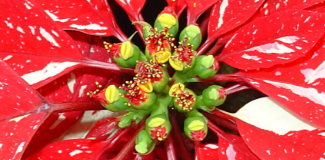Annuals
Continue to water cool season annuals. Garden centers are stocked with poinsettias this time of year. Be sure to protect them from drafts from outside doors and from heat vents. If they are wrapped in foil, be sure to remove it or puncture the foil to allow water to drain through. Poinsettias can easily drown if this is not done. Poinsettias are tropical plants native to Mexico, so they will not really grow and bloom here in South Carolina if planted outside. Our winters will kill them. It is best to just throw them away when the season is over.
Turf
Relax. Enjoy the break from the heat and mowing.
Perennials
Most perennials have gone dormant for the winter by now. Some exceptions to this are Lenten Rose, Japanese Tassal Ferns, Holly Ferns, Autumn Ferns, Thyme, Hardy Ice Plants, Heucheras, some daylilies, Cast Iron Plants, Sedums, Carex, Acorus Grass, some Dianthus, Creeping Raspberry, Ivy, and Wire Vine.
Roses
Do not fertilize roses this month. If ordering from a rose catalog, you should place your order no later than this month to ensure you get the cultivar you desire in time to plant in March.
Shrubs
Shrubs such as junipers, hollies, false hollies, and rosemary have been used as seasonal decorations in wreaths, on mantles, and over doorways by southerners for years. You can keep these cutting from drying out too fast by keeping them away from heat vents and by using antitranspirants. Antitranspirants are sold under names like Wilt Proof in garden centers. They coat a plant with a thin, waxy layer that prohibits transpiration from leaves. Simply spray this on the cuttings, and let dry before placing them as decorations.
Trees
The first Friday in December is South Carolina’s Arbor Day. School children traditionally plant trees at school on this day to celebrate the beginning of optimum tree planting season. December through March is the best time in South Carolina to plant trees. Did you know that trees planted on the western side of a building can lower summer cooling costs? Trees contribute so much to our world. Trees are sources of jobs, food, shade, oxygen, building materials, rayon, ice cream (Yes, ice cream!), paper, rubber, wood products, increase property values, and provide homes for wildlife. All this is in addition to being great places for kids to climb, hang a swing, and adding beauty to our world! These should be plenty of good reasons to plant a tree. Consider carefully your choice of tree, the site where it’s to be planted, and the size it will become when mature. Watch for overhead wires, don’t get too close to a building, walkway, or drive, and be sure that it won’t obscure your ability to see at corners or when pulling out of the driveway. When handling a tree, never carry it by the trunk. Hold it by the container and support the root ball. The planting hole should be 2-3 times the width of the root ball, but not any deeper. Gently loosen the roots of the tree before placing in the hole. Backfill the hole with soil, tamping it down with your foot to firm the soil. When the hole is half filled, water the hole to help settle the soil. Continue filling the soil. A water berm placed around the perimeter of the root ball will help keep water confined to the root zone when watering. Place mulch around the tree (not on it) at a depth of 3-4 inches. The tree will need to be hand watered daily for two weeks, and then every other day for an additional two weeks. After that water twice a week. Do not depend on an irrigation system for newly planted trees. Irrigation systems are designed to water established plants. Continue to water the tree throughout the winter.





